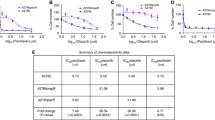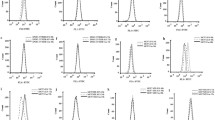Abstract
A number of amiloride analogs can sensitise wild type Chinese Hamster ovary (CHO) cells to the cytotoxic action of vinblastine, daunomycin, puromycin or colchicine. Some of these analogs also have weak sensitising effects on the multidrug resistant CHO cell line, CHRC5. The unusual feature of most of the active amiloride analogs is that they are more potent in reversing the intrinsic multidrug resistance (MDR) phenotype of CHO cells than their acquired MDR characteristic. Human HeLa cells that do not exhibit intrinsic MDR are not affected by these agents. Several of the amiloride analogs have a greater effect in increasing adriamycin uptake in wild type CHO cells than they do with CHRC5 cells. The differential effect of amiloride analogs on intrinsic versus acquired MDR characteristics of Chinese hamster cells suggests some differences in the underlying resistance mechanisms.
Similar content being viewed by others
Author information
Authors and Affiliations
Rights and permissions
About this article
Cite this article
Epand, R., Epand, R., Gupta, R. et al. Reversal of intrinsic multidrug resistance in Chinese hamster ovary cells by amiloride analogs. Br J Cancer 63, 247–251 (1991). https://doi.org/10.1038/bjc.1991.58
Issue Date:
DOI: https://doi.org/10.1038/bjc.1991.58
- Springer Nature Limited




